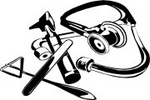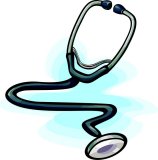
Worksheets and No Prep Teaching Resources
Reading Comprehension Worksheets
Medical Tools

Medical Tools
 Worksheets and No Prep Teaching Resources Reading Comprehension Worksheets Medical Tools |
 Medical Tools |
| edHelper's suggested reading level: | grades 4 to 6 | |
| Flesch-Kincaid grade level: | 6.39 |
|
Stethoscope
By Jennifer Kenny |

|
 1 Picture a doctor in your mind. Do you imagine a person with a white coat and a medical chart? What's around his or her neck? Most likely, the image produced in your mind showed a person with a stethoscope. That instrument is often considered the symbol of the doctor's profession.
1 Picture a doctor in your mind. Do you imagine a person with a white coat and a medical chart? What's around his or her neck? Most likely, the image produced in your mind showed a person with a stethoscope. That instrument is often considered the symbol of the doctor's profession. |
Create Weekly Reading Books
Prepare for an entire week at once! |
| Leave your feedback on Stethoscope (use this link if you found an error in the story) |
 |
Medical Tools
|